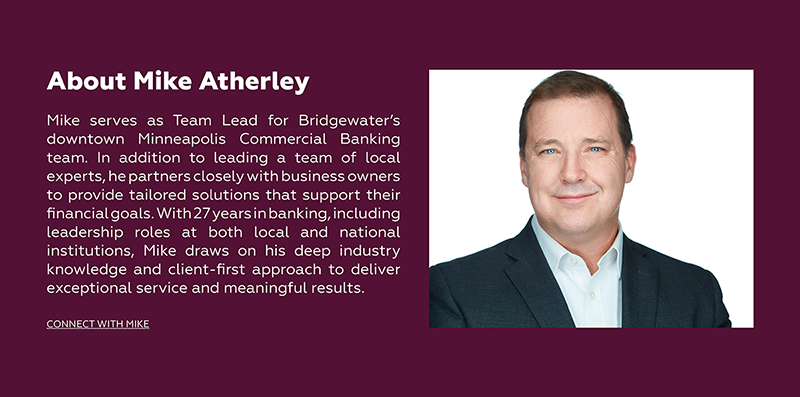
Unpacking the Capital Stack: How Banks View Capital in Sponsor Finance Transactions
By Michael Atherley, SVP Commercial Banking Team Lead
Whether you’re a business owner preparing for a sale, an independent sponsor raising capital, or a private equity investor evaluating opportunities, sponsor finance transactions can feel complicated.
With multiple layers of capital, varying structures, and competing priorities, the big question we often hear is: “How do banks really view these transactions, and what should you keep in mind when structuring them?”
At Bridgewater Bank, we’ve guided many clients through sponsor-backed acquisitions from initial structuring all the way to closing. And one thing is clear: understanding the capital stack is critical to building the right transaction and achieving the desired outcome.
Here’s a closer look at how it works and what matters most from a banker’s perspective.
Private Equity vs. Independent Sponsors
Before you evaluate a sponsor finance transaction, it’s important to understand who’s on the other side of the table. In our experience, that’s usually a private equity (PE) fund or an independent sponsor. While both invest in growing companies, their approach and capital base differ.
- PE Funds raise large pools of capital through subscription agreements. Their typical hold period is five to seven years, with a defined plan to exit in another five to seven years. We often see PE investors focusing on scaling quickly, driving profitability, and increasing efficiency.
- Independent Sponsors raise capital on a deal-by-deal basis, often through a smaller group of investors or a family office. Without the pressure of a fixed fund life, they may take a longer view, focusing on sustainable growth and steady dividends over time.
Understanding the type of sponsor you’re working with is critical, as it shapes transaction structure, expectations, and the pace of growth.
Anatomy of a Transaction
Once you know who’s driving the deal, the next step is understanding how the financing typically comes together. Most sponsor-led acquisitions fall in the range of 3–7x adjusted EBITDA, and the purchase price is financed through a mix of capital sources, including:
- Sponsor equity: typically 25% or more of the purchase price.
- Senior debt: 2–3x EBITDA, usually secured by business assets, often with a working capital line attached.
- Mezzanine or subordinated debt: 1–1.5x EBITDA., carrying higher risk and subordinated to senior lenders.
- Seller rollover equity: 10–30%, aligning seller and buyer interests.
- Earnouts: performance-based payments post-closing, though less common today.
Banks like Bridgewater evaluate each component of the stack for repayment ability, collateral coverage, and alignment between sponsor and seller. And because we understand no two transactions are alike, the Bridgewater approach focuses on flexibility, ensuring financing structures are both sound and adaptable for long-term success.
Why Sell to a Sponsor?
Knowing how a transaction is structured is only part of the picture. The bigger question many clients ask us is: why sell to a sponsor in the first place? For many business owners, selling to a PE fund or independent sponsor provides more than just liquidity. It can also mean:
- Growth capital and expertise to scale the business and pursue acquisitions.
- A second liquidity event through rollover equity.
- Added professionalization, including governance, acquisition vetting, and strong management recruitment.
For entrepreneurs who want to de-risk while still participating in the company’s future, sponsor partnerships can be compelling. Still, it’s important to understand the financial implications and work with a banking partner who can help you see the full financial picture and structure a transaction that balances opportunity with protection.
Risks to Consider
Since no transaction is without trade-offs, our team works closely with clients early in the process to assess readiness, weigh scenarios, and anticipate how a potential sale might affect operations and ownership. We encourage those exploring a sale to consider key risks, including:
- Loss of control, as decision-making shifts to new owners.
- Cultural misalignment if the sponsor and board aren’t the right fit.
- Operational strain from aggressive growth plans.
Clarity around your goals, whether maximizing value, protecting culture, or remaining active in the business, helps mitigate these risks.
Build the Right Advisory Team
These risks don’t mean a sale isn’t the right choice, but they do highlight why having the right advisory team around you is critical. As we like to say at Bridgewater, “the most successful transactions start years before the sale.” This is why we encourage clients to assemble a team of trusted advisors early, including:
- A wealth manager to plan for post-sale income.
- A CPA to prepare financials and optimize tax strategy.
- An attorney to structure the transaction and address liability.
- An investment banker to market the business and find the right buyer.
- A commercial banker to connect you with sponsors and evaluate financing.
It's important to note that your long-time advisors may not always be the best fit. Look for professionals with direct transaction experience and interview them carefully to ensure they align with your goals.
Positioning for Success
Ultimately, the groundwork you lay, from assembling the right advisors to strengthening your business ahead of a sale, can make the difference between a good outcome and a great one.
Selling to a sponsor can take years of preparation and up to a year to close. Owners who invest in efficiency, strengthen earnings, and align with the right advisors often achieve better outcomes, both financially and strategically.
At Bridgewater Bank, we’ve successfully guided many clients through this process. Whether it’s connecting you to trusted sponsors, structuring senior financing, or helping evaluate options, our team is here to provide clarity and confidence. Connect with a local expert today>>> https://bridgewaterbankmn.com/inquire
Member FDIC | Equal Housing Lender


